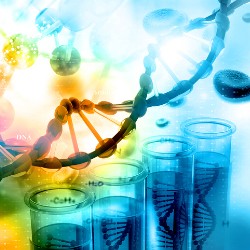Could a Cancer Protein Be at the Heart of Cardiac Scarring and Disease?
A protein famous for stunting tumor growth might seem out of place in a discussion about heart disease and scarring, but research supported in part by the UR CTSI suggests that the tumor suppressor protein p53 might play an important role in both. University of Rochester Medical Center researchers believe that having too much p53 may speed progression of a disease marked by loss of heart muscle, while having too little p53 could tip the scales from repair to harmful scarring after a cardiac injury such as a heart attack.
Small and his collaborators Chen Yan, PhD, Peng Yao, PhD, and Craig Morrell, DVM, PhD, have turned $250,000 of funding from the UR CTSI (including a $200,000 Incubator grant and a $50,000 Faculty Pilot Award) into $8.2 million of research funding from the National Heart, Lung, and Blood Institute (NHLBI)—and a plethora of high-impact publications.
“CTSI funding has facilitated research that supported high impact publications, and has led to considerable extramural funding for my own lab, and also collaborative research grants for myself and other CVRI faculty,” said Small. “I think the return on investment is quite impressive!”
Absence (of p53) Makes the Heart Grow Firmer
Scarring of the heart, also called cardiac fibrosis, happens when the mechanisms meant to repair heart tissue run amok. In response to injury, cells called fibroblasts begin multiplying and secreting a scaffold of molecules that help patch and repair damaged tissue. If too many fibroblasts are created and too much of that scaffolding, called extracellular matrix, is released, the heart begins to scar and become rigid, impeding its ability to pump normally.
In a study recently published in Circulation Research, URMC researchers found that mouse heart fibroblasts multiply during a discrete window after injury, and fibroblast proliferation seemed to be tied to a lack of p53, the tumor suppressor protein that normally puts the brakes on cell proliferation.
“Fibroblasts don't start proliferating right away,” said Eric Small, PhD, associate professor of Medicine in the Aab Cardiovascular Research Institute (CVRI), who led the research. “About a week after injury in mice, fibroblasts start multiplying like crazy—but just in that second week. We found that p53 activity seems to be a little bit lower in that second week, allowing the cells to proliferate.”
In the study, which was supported in part by an Incubator Award from the UR CTSI, Small’s team mimicked high blood pressure in mice using a left ventricle overload model. Mice that did not express p53 in heart fibroblasts showed “striking accumulation” of fibroblasts and more scarring of the heart in response to this injury compared to mice that expressed normal levels of p53. Whether p53 was expressed or not, fibroblasts only multiplied during the second week after injury, suggesting p53 plays an important role in regulating the amount of fibroblast proliferation, but not in its timing.
Small and his colleagues are close to defining the point at which fibroblast proliferation tips over into being detrimental in mice and hope to eventually determine the same threshold for humans. Once they identify that window, they will explore ways to enhance p53 levels during that time to see if it can keep fibroblast proliferation in check and prevent scarring.
One possible way to do that is to inhibit a protein called MDM2, which causes p53 to be broken down and removed from the cell. MDM2 inhibitors are currently being tested in cancer clinical trials, but have not been tested in the context of heart disease—and there is still a lot of research yet to be done before they can be.
“In mouse models, it seems that targeting the fibroblast and reducing fibrosis is proving to be beneficial,” said Small. “Seeing how that applies to the human condition is the next step.”
Too Much of a Good Thing
While too little p53 may contribute to cardiac scarring, too much of it may speed progression of a deadly heart disease called arrhythmogenic right ventricle cardiomyopathy (ARVC), in which heart muscle deteriorates over time causing abnormal heart beat.
Many patients with ARVC carry mutations in the PKP2 gene, which codes for a protein that plays an important role in the structural and functional connection between heart muscle cells. These connections, called desmosomes, help coordinate muscle contraction.
In a study published in Circulation, Small’s collaborators Alicia Lundby, PhD, of the University of Copenhagen and Mario Delmar, MD, PhD, of New York University, found high levels of p53 pathway proteins in heart muscle biopsies from patients with ARVC and PKP2 mutations. Compared to healthy family members, these patients also had more damage to the nuclear membranes and DNA in their heart muscle cells.
With pilot funding from the UR CTSI, Small investigated whether structural changes in the desmosome—caused by PKP2 mutations—disrupt the nuclear membrane in heart muscle cells, thereby inducing the DNA damage response and activating p53, which could speed cell death and worsen disease. Those studies, conducted in mice that lack PKP2 in heart muscle cells, led to a new $2.8 million grant from the National Heart, Lung, and Blood Institute, which Small, Lundby, and Delmar will use to better understand how PKP2 mutations disrupt the nuclear membrane and DNA of heart muscle cells and devise ways to reduce DNA damage and delay heart muscle cell death.
“We're at the beginning stages of identifying what some of these most important gene changes and structural changes are, whether they're functionally contributing to the disease, and whether we can reverse that somehow,” said Small.
Down the line, Small envisions using gene therapy to either knock down disease-causing genes or replace genes that have been quieted by the disease.
###
Small’s research was supported by a 2018 Incubator Award and a 2022 Faculty Pilot Award, both of which are supported by the University of Rochester CTSA (UL1 TR002001) from the National Center for Advancing Translational Sciences of the National Institutes of Health. The content is solely the responsibility of the authors and does not necessarily represent the official views of the National Institutes of Health.
Michael Hazard | 11/8/2023



